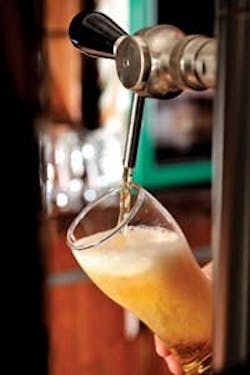Commercial Systems: Brewing a Better Business
About the author: Dave Allen is product group manager for Xylem’s Applied Water Systems business unit. Allen can be reached at 949.608.3930.
In ancient civilizations, people drank fermented cereal through straws, a crude predecessor to modern-day draft beer. The carbonation and aroma created through fermentation enhanced the enjoyment and flavor. Then, as now, beer drinkers sought to preserve and complement flavor.
Draft beer as we know it today gained popularity in the 1950s in the U.K. and has been the preferred way for consumers to enjoy the bitter, earthy and citrusy flavors derived from hops ever since. In today’s brewing revolution, new beers and styles are created daily as brewers develop unique and distinguishable flavors and aromas. The levels of naturally occurring gases in the beers are critical to the flavor intended by the brewer, making the draft beer delivery system an important component in the process. The biggest challenge for restaurant and bar operators is how to preserve these flavors and ensure quality is not lost as beer travels from the keg through the tap into the glass.
The majority of beer brewed and packaged in the U.S. is unpasteurized, therefore, any beer dispensing system must be designed with freshness in mind, from the first pull of the tap to the last drop in the keg. Many microbreweries, craft breweries, restaurants, bars and home brewers use beer pumps to ensure product consistency.
Quality Counts
Increased distances from keg to tap have resulted in extended line runs. One method for accommodating these longer runs is using alternative pressurized gases, such as nitrogen, to drive the beer from keg to tap. This method can have some impact on the quality of the dispensed beer and the yield of the keg.
In a commercial setting, selecting a beverage-dispensing supplier with deep application knowledge can help beverage purveyors find solutions that meet all of their needs. It takes more than just attaching a tube to a pump and turning on the tap to maintain draft beer’s quality. Systems require detailed design, precise operating conditions and regular maintenance to guarantee proper beer dispensing.
Beer pumps are an alternative to blended gases for systems with higher pressure requirements, such as longer runs or rises from cooler to tap. Often, craft and specialty beer blends require an ideal pressure designed for a specific CO2 pressure inside the keg. A pump, driven by air, enables proper pressure to be applied to the keg to ensure the correct internal carbonation of the product. The liquid then is pushed through the tap, so air or gas do not come in direct contact with the beer. This provides protection from flat or tainted beer due to air contamination or oxidation.
Beer pumps move the liquid to the tap or faucet in draft systems and perform three critical functions:
1. Pushing the beer from the keg to the tap;
2. Maintaining the carbonation level of the beer from start to finish. Beer pumps allow keg pressure to be set independently of line length, allowing the keg pressure to be maintained exactly as the brewer intended; and
3. Preserving the flavor of the beer in the keg. Added or pressurized gas driving the beer can have an impact on flavor. Use of a beer pump eliminates this.
The Flojet brand is one example of a line of pumps designed to dispense beer at the brewer-specified keg-top pressure, through either long or short, vertical or horizontal beer runs. The pumps are pneumatically driven by compressed air or bottled gas. By using the pumps, the correct equilibrium of pressure is maintained in the keg, keeping the carbonation level of the beer exactly as the brewer intended it to be served.
“At Xylem, we are consistently testing and adding products that will advance the industry and increase reliability for our customers in the Flojet beverage line,” said Peter Wright, market segment director for Xylem. “We understand how precious a restaurant’s tap quality is and take pride in supporting those needs for our end customers.”
Better Beer, Higher Profits
A properly matched beer pump not only maintains beer’s fresh taste, it also can result in an above-average yield from each keg. By reducing waste caused from over-pouring, beer pumps can improve beverage providers’ bottom lines.
A key to maintaining the quality of beer dispensed and repeated business is clean lines. According to a recent white paper, “The Economic Benefits of Line Cleaning,” Wisconsin industry data illustrate a two-week line cleaning cycle resulted in a 4% sales increase compared to locations not using the two-week cycle. In the same study, when line cleaning was conducted only every five to eight weeks, draft beer sales dropped 7%. These findings highlight the importance of scheduled cleanings to provide a consistently good-tasting product.
A majority of beer pumps also can be used as line-cleaning pumps by disconnecting the keg coupler and submerging them in cleaning solution. The pump will draw solution in and pump it through the system to
the faucet.
The fundamental elements of maintaining the flavor quality of dispensed beer to maximize keg yield are setting the keg pressure as intended by the brewer, even when dealing with long runs, and managing clean lines.
Beer pumps are ideal for bars and pubs seeking to improve beverage quality and continue to capitalize on the craft beer trend. As beverage purveyors invest in advanced technologies and properly maintain dispensing systems, they will minimize waste and maximize profit.
Download: Here
